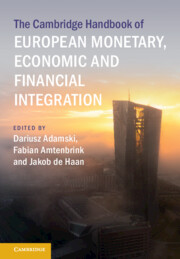Book contents
- The Cambridge Handbook of European Monetary, Economic and Financial Integration
- The Cambridge Handbook of European Monetary, Economic and Financial Integration
- Copyright page
- Contents
- Contributors
- Introduction
- Part I The Economic and Monetary Union
- Part II The Monetary Dimension
- Part III The Economic and Fiscal Dimensions
- Part IV Financial Integration
- 23 Banking Regulation in Europe
- 24 The Politics behind the Creation of the Banking Union
- 25 Failing Banks within the Banking Union at the Crossroads
- 26 The Banking Union
- 27 The Re-emergence of Market-Based Finance?
- 28 The European Strategy on Digital Finance and Its Interplay with Capital Markets Integration in the EU
- 29 Regulating Crypto and Cyberware in the EU
- Index
- References
29 - Regulating Crypto and Cyberware in the EU
from Part IV - Financial Integration
Published online by Cambridge University Press: 28 September 2023
- The Cambridge Handbook of European Monetary, Economic and Financial Integration
- The Cambridge Handbook of European Monetary, Economic and Financial Integration
- Copyright page
- Contents
- Contributors
- Introduction
- Part I The Economic and Monetary Union
- Part II The Monetary Dimension
- Part III The Economic and Fiscal Dimensions
- Part IV Financial Integration
- 23 Banking Regulation in Europe
- 24 The Politics behind the Creation of the Banking Union
- 25 Failing Banks within the Banking Union at the Crossroads
- 26 The Banking Union
- 27 The Re-emergence of Market-Based Finance?
- 28 The European Strategy on Digital Finance and Its Interplay with Capital Markets Integration in the EU
- 29 Regulating Crypto and Cyberware in the EU
- Index
- References
Summary
As the EU is finalizing measures for the regulation of cryptocurrencies and the digital resilience of financial institutions, this chapter describes the pros and cons of the new approach for regulating crypto, and assesses the framework for ICT oversight. Both regulations, Markets in Crypto-Assets (MICA) and Digital Operational Resilience Act (DORA), introduce a host of new provisions, and fundamentally change the regulatory framework for digital operations in finance in the EU. Crypto providers will be subject to a new set of rules in MICA, outside the existing rules for investment providers that are governed by the Markets in Financial Instruments Directive (MiFID). But the digital governance of all financial firms will be more strictly regulated under DORA, including the third-party ICT providers.
- Type
- Chapter
- Information
- Publisher: Cambridge University PressPrint publication year: 2023

